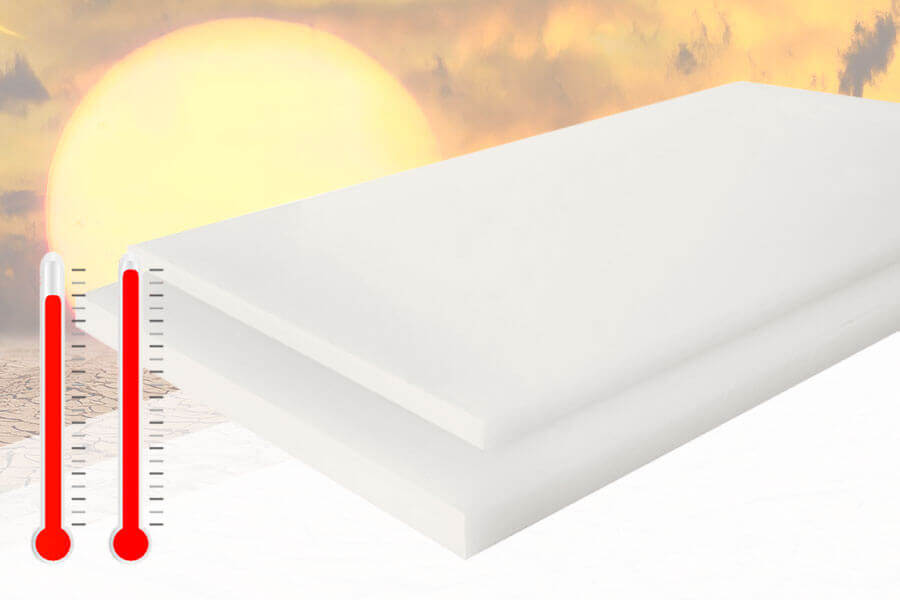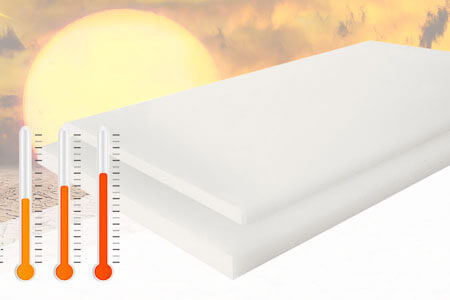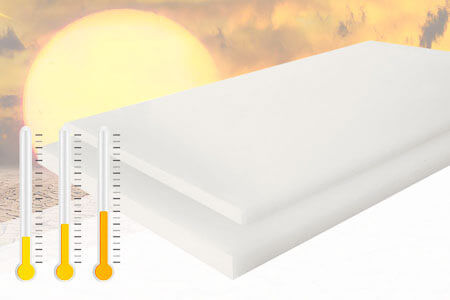Posted on Mar 21, 2018
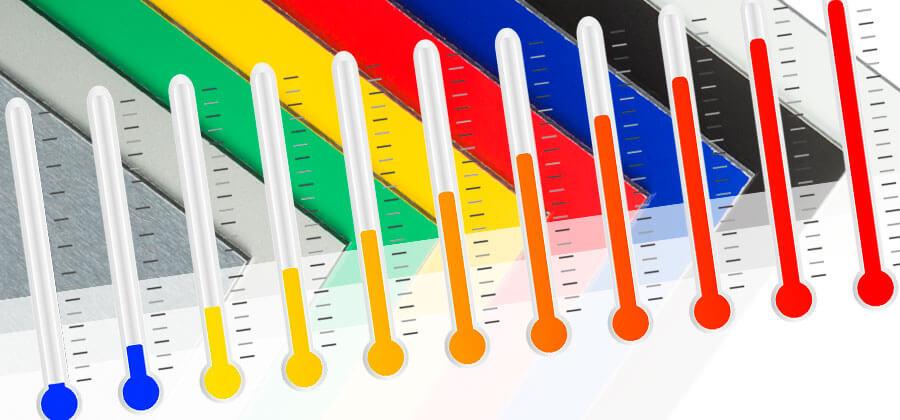
Not every plastic is heat resistant and not all plastics can be used at sub-zero temperatures. We at S-Polytec tell you at which use temperatures which plastic can be used.
When which plastic can be used at which temperatures is one of the questions we receive most frequently.
This information can be found both in the category description and in the data sheets, but especially if you do not yet know which plastic is generally suitable for the required temperature range, the search becomes tedious and nerve-wracking.
However, we are putting an end to this here and now.
Plastics differ not only in their colour, but also in their chemical composition and their basic properties. Especially with thermoplastics, it is therefore very important to also pay attention to the temperature resistance properties, because not every plastic can tolerate high temperatures or can be used in sub-zero temperatures.
Why are application temperatures so important for plastics?
If a plastic is used at temperatures that are too low, its load-bearing capacity drops enormously under stress. In the worst case, this can lead to material failure or breakage.
If a plastic is used at too high temperatures, it can soften depending on the duration of the thermal overload, which again leads to material failure and unwanted deformation. In addition, if the temperature is too high, thermal decomposition of the plastic can occur, causing the plastic to become unusable even after cooling.
Temperature application ranges of our plastics
Below you will find a list of all plastics in our online shop with the corresponding temperature application ranges. The sorting starts with the plastic with the largest temperature application range and ends with the plastic that has only a small temperature application range.
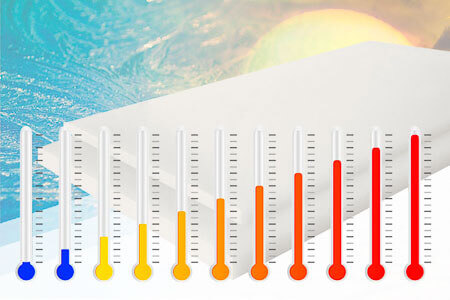
From -200°C to +260°C -
PTFE (polytetraflourethylene, Teflon)
From -260°C to +80°C -
PE-UHMW (PE-1000, polyethylene)
From -100°C to +80°C -
PE-HMW (PE-500, polyethylene)
From -40°C to +100°C -
PC (polycarbonate clear, transparent)
From -50°C to +80°C -
PE-UHMW Regenerate (PE-1000 regenerate, polyethylene)
From -50°C to +80°C -
PE-HD (polyethylene)
From -50°C to +80°C -
PE-HD with grain on both sides (polyethylene)
From -50°C to +80°C -
Alu composite panels
From -40°C to +80°C -
PMMA (acrylic clear, transparent)
From -40°C to +80°C -
PMMA (acrylic opal, milky cloudy)
From -30°C to +80°C -
HPL (High Pressure Laminate)
From -40°C to +65°C -
PETG (clear, transparent)
From 0 to +100°C -
PP-H (polypropylene)
From 0 to +100°C -
PP-S (polypropylene, flame retardant)
From -10°C to +90°C -
ABS (acrylonitrile-butadiene-styrene copolymer)
From -10°C to +90°C -
ASA/ABS (acrylonitrile-butadiene-styrene copolymer with UV-resistant ASA top layer)
From -20°C to +80°C -
PE-EL (polyethylene, electrically conductive)
From -20°C to +80°C -
DecoVitas (decorative panels)
From 0 to +80°C -
PP-EL-S (polypropylene, electrically conductive)
From -10°C to +70°C -
PS (polystyrene)
From -20°C to +60°C -
Hard PVC-UV (polyvinyl chloride, UV resistant)
From 0 to +60°C -
Hard PVC glass (clear, transparent)
From 0 to +60°C -
Hard PVC (polyvinyl chloride)
Frost resistant plastics
Not all plastics are suitable for applications below freezing point, so we have listed all our plastics that can also be used at sub-zero temperatures. Let's start with the plastics that can also be used permanently at very low temperatures.
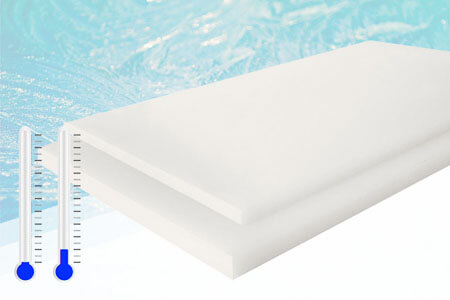
Up to -260°C -
PE-UHMW (PE-1000, polyethylene)
To -200°C -
PTFE (polytetraflourethylene, Teflon)
To -100°C -
PE-HMW (PE-500, polyethylene)
To -50°C -
PE-UHMW Regenerated (PE-1000 Regenerated, Polyethylene)
To -50°C -
PE-HD (polyethylene)
To -50°C -
PE-HD with grain on both sides (polyethylene)
Up to -50°C -
Alu composite panels
To -40°C -
PMMA (acrylic clear, transparent)
To -40°C -
PMMA (acrylic opal, milky cloudy)
To -40°C -
PC (polycarbonate clear, transparent)
To -40°C -
PETG (clear, transparent)
To -30°C -
HPL (high pressure laminate)
To -20°C -
Hard PVC UV (polyvinyl chloride, UV resistant)
To -20°C -
PE-EL (polyethylene, electrically conductive)
To -20°C -
DecoVitas (decorative panels)
To -10°C -
ABS (acrylonitrile-butadiene-styrene copolymer)
To -10°C -
ASA/ABS (acrylonitrile-butadiene-styrene copolymer with UV-resistant ASA topcoat)
To -10°C -
PS (polystyrene)
NOTE:All other plastics in our shop can only be used at temperatures from zero degrees and are therefore not considered frost-resistant.
Heat resistant plastics
If you are looking for plastics that are permanently exposed to high temperatures, you should take a closer look at the following table.
High heat resistant plastics
Up to +260°C -
PTFE (polytetraflourethylene, Teflon)
Heat-resistant plastics up to 100°C
Up to +100°C -
PC (polycarbonate clear, transparent)
To +100°C -
PP-H (polypropylene)
To +100°C -
PP-S (polypropylene, flame retardant)
Heat resistant plastics below 100°C
Up to +90°C -
ABS (acrylonitrile-butadiene-styrene copolymer)
Up to +90°C -
ASA/ABS (acrylonitrile-butadiene-styrene copolymer with UV-resistant ASA topcoat)
Up to +80°C -
PE-UHMW (PE-1000, polyethylene)
To +80°C -
PE-UHMW Regenerated (PE-1000 Regenerated, Polyethylene)
Up to +80°C -
PE-HMW (PE-500, polyethylene)
To +80°C -
PE-HD (polyethylene)
To +80°C -
PE-HD with grain on both sides (polyethylene)
Up to +80°C -
PE-EL (polyethylene, electrically conductive)
To +80°C -
PP-EL-S (Polypropylene, electrically conductive)
Up to +80°C -
PMMA (clear acrylic, transparent)
To +80°C -
PMMA (acrylic opal, milky cloudy)
Up to +80°C -
Alu composite sheets
To +80°C -
HPL (high pressure laminate)
Up to +80°C -
DecoVitas (decorative panels)
Up to +70°C -
PS (polystyrene)
To +65°C -
PETG (clear, transparent)
To +60°C -
Hard PVC glass (clear, transparent)
To +60°C -
Hard PVC UV (polyvinyl chloride, UV resistant)
Up to +60°C -
Hard PVC (polyvinyl chloride)




